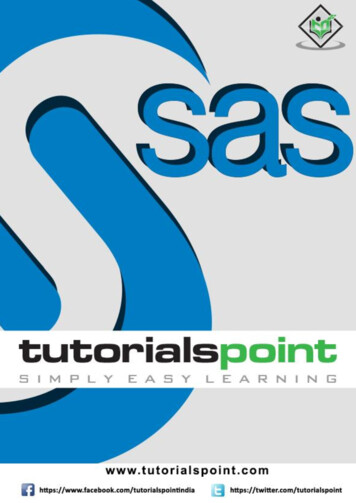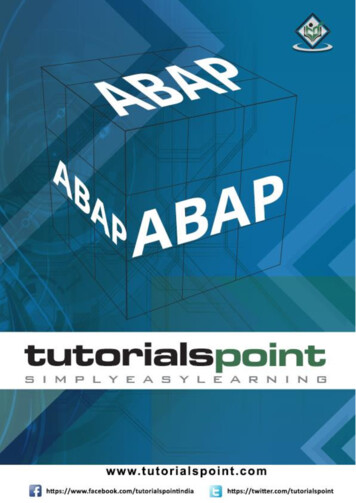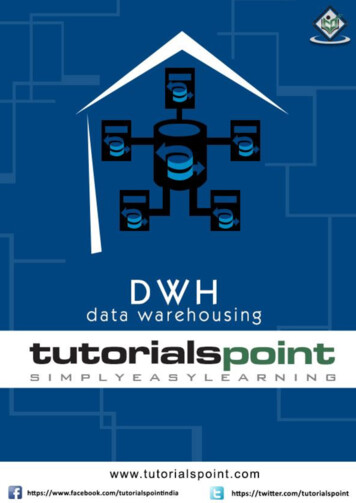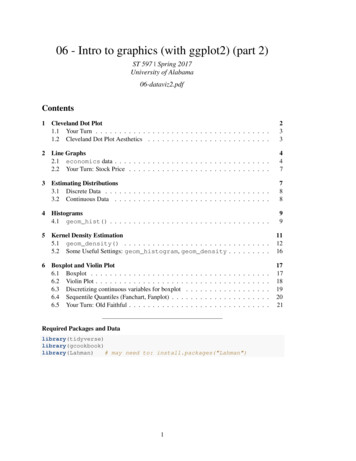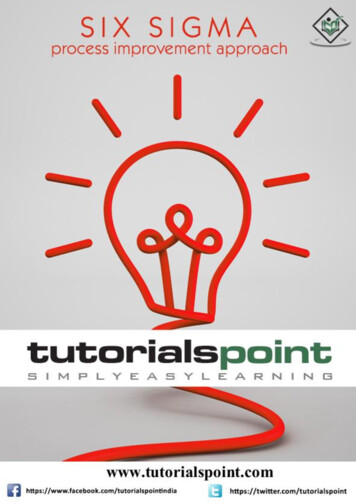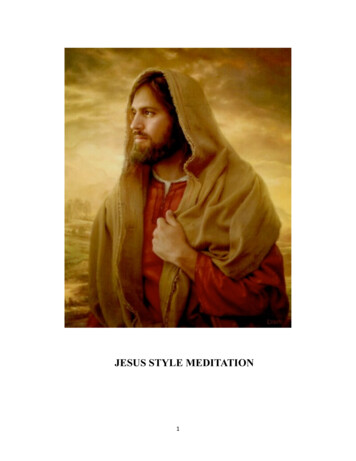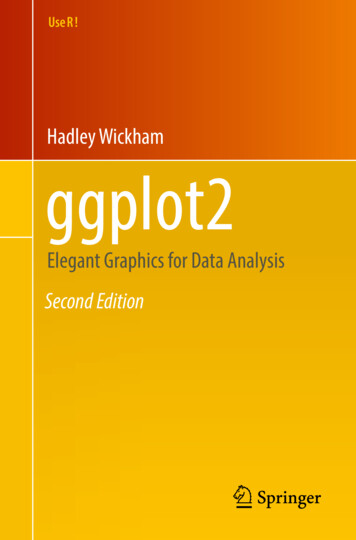
Transcription
UseR !Hadley Wickhamggplot2Elegant Graphics for Data AnalysisSecond Edition
Use R!Series Editors:Robert Gentleman Kurt Hornik Giovanni ParmigianiMore information about this series at http://www.springer.com/series/6991
Use R!Moore: Applied Survival Analysis Using RLuke: A User’s Guide to Network Analysis in RMonogan: Political Analysis Using RCano/M. Moguerza/Prieto Corcoba: Quality Control with RSchwarzer/Carpenter/Rücker: Meta-Analysis with RGondro: Primer to Analysis of Genomic Data Using RChapman/Feit: R for Marketing Research and AnalyticsWillekens: Multistate Analysis of Life Histories with RCortez: Modern Optimization with RKolaczyk/Csárdi: Statistical Analysis of Network Data with RSwenson/Nathan: Functional and Phylogenetic Ecology in RNolan/Temple Lang: XML and Web Technologies for Data Sciences with RNagarajan/Scutari/Lèbre: Bayesian Networks in Rvan den Boogaart/Tolosana-Delgado: Analyzing Compositional Data with RBivand/Pebesma/Gómez-Rubio: Applied Spatial Data Analysis with R(2nd ed. 2013)Eddelbuettel: Seamless R and C Integration with RcppKnoblauch/Maloney: Modeling Psychophysical Data in RLin/Shkedy/Yekutieli/Amaratunga/Bijnens: Modeling Dose-Response MicroarrayData in Early Drug DevelopmentExperiments Using RCano/M. Moguerza/Redchuk: Six Sigma with RSoetaert/Cash/Mazzia: Solving Differential Equations in R
Hadley Wickhamggplot2Elegant Graphics for Data AnalysisSecond EditionWith contributions by Carson Sievert123
Hadley WickhamRStudioHouston, Texas, USAISSN 2197-5736Use R!ISBN 978-3-319-24275-0DOI 10.1007/978-3-319-24277-4ISSN 2197-5744 (electronic)ISBN 978-3-319-24277-4 (eBook)Library of Congress Control Number: 2016937314 The Author 2016This work is subject to copyright. All rights are reserved by the Publisher, whether the whole or part ofthe material is concerned, specifically the rights of translation, reprinting, reuse of illustrations, recitation,broadcasting, reproduction on microfilms or in any other physical way, and transmission or informationstorage and retrieval, electronic adaptation, computer software, or by similar or dissimilar methodologynow known or hereafter developed.The use of general descriptive names, registered names, trademarks, service marks, etc. in this publicationdoes not imply, even in the absence of a specific statement, that such names are exempt from the relevantprotective laws and regulations and therefore free for general use.The publisher, the authors and the editors are safe to assume that the advice and information in this bookare believed to be true and accurate at the date of publication. Neither the publisher nor the authors orthe editors give a warranty, express or implied, with respect to the material contained herein or for anyerrors or omissions that may have been made.Printed on acid-free paperThis springer imprint is published by Springer NatureThe registered company is Springer International Publishing AG Switzerland
To my parents, Alison & Brian Wickham.Without them, and their unconditionallove and support, none of this would havebeen possible.
PrefaceWelcome to the second edition of “ggplot2: elegant graphics for dataanalysis”. I’m so excited to have an updated book that shows off all thelatest and greatest ggplot2 features, as well as the great things that havebeen happening in R and in the ggplot2 community the last 5 years. Theggplot2 community is vibrant: the ggplot2 mailing list has over 7,000members and there is a very active Stack Overflow community, with nearly10,000 questions tagged with ggplot2. While most of my development effortis no longer going into ggplot2 (more on that below), there’s never been abetter time to learn it and use it.I am tremendously grateful for the success of ggplot2. It’s one of the mostcommonly downloaded R packages (over a million downloads in the last year!)and has influenced the design of graphics packages for other languages. Personally, ggplot2 has brought me many exciting opportunities to travel theworld and meet interesting people. I love hearing how people are using R andggplot2 to understand the data that they care about.A big thanks for this edition goes to Carson Sievert, who helped me modernise the code, including converting the sources to R Markdown. He alsoupdated many of the examples and helped me proofread the book.Major ChangesI’ve spent a lot of effort ensuring that this edition is a true upgrade overthe first. As well as updating the code everywhere to make sure it’s fullycompatible with the latest version of ggplot2, I have: Shown much more code in the book, so it’s easier to use as a reference.Overall the book has a more “knitr”-ish sensibility: there are fewer floatingfigures and tables and more inline code. This makes the layout a little lesspretty but keeps related items closer together.vii
viiiPreface Published the complete source online at https://github.com/hadley/ggplot2-book. Switched from qplot() to ggplot() in the introduction, Chap. 2. Feedbackindicated that qplot() was a crutch: it makes simple plots a little easier,but it doesn’t help with mastering the grammar. Added practice exercises throughout the book so you can practise newtechniques immediately after learning about them. Added pointers to the rich ecosystem of packages that have built up aroundggplot2. You’ll now see a number of other packages highlighted in the bookand get pointers to other packages I think are particularly useful. Overhauled the toolbox chapter, Chap. 3, to cover all the new geoms. I’veadded a completely new section on text labels, Sect. 3.3, since it’s important and not covered in detail elsewhere. The mapping section, Sect. 3.7,has been considerably expanded to talk more about the different types ofmap data and where you might find them. Completely rewritten the scales chapter, Chap. 6, to focus on the mostimportant tasks. It also discusses the new features that give finer controlover legend appearance, Sect. 6.4, and shows off some of the new scalesadded to ggplot2, Sect. 6.6. Split the data analysis chapter into three pieces: data tidying (with tidyr),Chap. 9; data manipulation (with dplyr), Chap. 10; and model visualisation (with broom), Chap. 11. I discuss the latest iteration of my datamanipulation tools and introduce the fantastic broom package by DavidRobinson.The book is accompanied by a new version of ggplot2: version 2.0.0. Thisincludes a number of minor tweaks and improvements, and considerable improvements to the documentation. Coming back to ggplot2 development aftera considerable pause has helped me to see many problems that previously escaped notice. ggplot2 2.0.0 (finally!) contains an official extension mechanismso that others can contribute new ggplot2 components in their own packages.This is documented in a new vignette, vignette(‘‘extending-ggplot2").The Futureggplot2 is now stable and is unlikely to change much in the future. There willbe bug fixes and there may be new geoms, but there will be no large changes tohow ggplot2 works. The next iteration of ggplot2 is ggvis. ggvis is significantlymore ambitious because it aims to provide a grammar of interactive graphics.ggvis is still young and lacks many of the features of ggplot2 (most notablyit currently lacks facetting and has no way to make static graphics), but overthe coming years the goal is to make ggvis better than ggplot2.The syntax of ggvis is a little different to ggplot2. You won’t be ableto trivially convert your ggplot2 plots to ggvis, but we think the cost is
Prefaceixworth it: the new syntax is considerably more consistent and will be easierfor newcomers to learn. If you’ve mastered ggplot2, you’ll find your skillstransfer very well to ggvis and after struggling with the syntax for a while, itwill start to feel quite natural. The important skills you learn when masteringggplot2 are not the programmatic details of describing a plot in code, butthe much harder challenge of thinking about how to turn data into effectivevisualisations.AcknowledgementsMany people have contributed to this book with high-level structural insights, spelling and grammar corrections and bug reports. I’d particularlylike to thank William E.J. Doane, Alexander Forrence, Devin Pastoor, DavidRobinson and Guangchuang Yu for their detailed technical reviews of thebook.Many others have contributed over the (now quite long!) lifetime of ggplot2. I would like to thank Leland Wilkinson, for discussions and commentsthat cemented my understanding of the grammar; Gabor Grothendieck, forearly helpful comments; Heike Hofmann and Di Cook, for being great advisors and supporting the development of ggplot2 during my PhD; CharlotteWickham; the students of stat480 and stat503 at ISU, for trying it out whenit was very young; Debby Swayne, for masses of helpful feedback and advice;Bob Muenchen, Reinhold Kliegl, Philipp Pagel, Richard Stahlhut, BaptisteAuguie, Jean-Olivier Irisson, Thierry Onkelinx and the many others who haveread draft versions of the book and given me feedback; and last, but not least,the members of R-help and the ggplot2 mailing list, for providing the manyinteresting and challenging graphics problems that have helped motivate thisbook.Chief Scientist, RStudioHouston, TX, USASeptember 2015Hadley Wickham
ContentsPart I Getting Started1Introduction . . . . . . . . . . . . . . . . . . . . . . . . . . . . . . . . . . . . . . . . . . . . . . 31.1 Welcome to ggplot2 . . . . . . . . . . . . . . . . . . . . . . . . . . . . . . . . . . . . . 31.2 What Is the Grammar of Graphics? . . . . . . . . . . . . . . . . . . . . . . . 41.3 How Does ggplot2 Fit in with Other R Graphics? . . . . . . . . . . . 51.4 About This Book . . . . . . . . . . . . . . . . . . . . . . . . . . . . . . . . . . . . . . . 71.5 Installation . . . . . . . . . . . . . . . . . . . . . . . . . . . . . . . . . . . . . . . . . . . . 81.6 Other Resources . . . . . . . . . . . . . . . . . . . . . . . . . . . . . . . . . . . . . . . . 81.7 Colophon . . . . . . . . . . . . . . . . . . . . . . . . . . . . . . . . . . . . . . . . . . . . . . 8References . . . . . . . . . . . . . . . . . . . . . . . . . . . . . . . . . . . . . . . . . . . . . . . . . 102Getting Started with ggplot2 . . . . . . . . . . . . . . . . . . . . . . . . . . . . .2.1 Introduction . . . . . . . . . . . . . . . . . . . . . . . . . . . . . . . . . . . . . . . . . . .2.2 Fuel Economy Data . . . . . . . . . . . . . . . . . . . . . . . . . . . . . . . . . . . . .2.2.1 Exercises . . . . . . . . . . . . . . . . . . . . . . . . . . . . . . . . . . . . . . . .2.3 Key Components . . . . . . . . . . . . . . . . . . . . . . . . . . . . . . . . . . . . . . .2.3.1 Exercises . . . . . . . . . . . . . . . . . . . . . . . . . . . . . . . . . . . . . . . .2.4 Colour, Size, Shape and Other Aesthetic Attributes . . . . . . . . .2.4.1 Exercises . . . . . . . . . . . . . . . . . . . . . . . . . . . . . . . . . . . . . . . .2.5 Facetting . . . . . . . . . . . . . . . . . . . . . . . . . . . . . . . . . . . . . . . . . . . . . .2.5.1 Exercises . . . . . . . . . . . . . . . . . . . . . . . . . . . . . . . . . . . . . . . .2.6 Plot Geoms . . . . . . . . . . . . . . . . . . . . . . . . . . . . . . . . . . . . . . . . . . . .2.6.1 Adding a Smoother to a Plot . . . . . . . . . . . . . . . . . . . . . .2.6.2 Boxplots and Jittered Points . . . . . . . . . . . . . . . . . . . . . . .2.6.3 Histograms and Frequency Polygons . . . . . . . . . . . . . . . .2.6.4 Bar Charts . . . . . . . . . . . . . . . . . . . . . . . . . . . . . . . . . . . . . .2.6.5 Time Series with Line and Path Plots . . . . . . . . . . . . . . .2.6.6 Exercises . . . . . . . . . . . . . . . . . . . . . . . . . . . . . . . . . . . . . . . .2.7 Modifying the Axes . . . . . . . . . . . . . . . . . . . . . . . . . . . . . . . . . . . . .111112121314141616171818202224252627xi
xiiContents2.8 Output . . . . . . . . . . . . . . . . . . . . . . . . . . . . . . . . . . . . . . . . . . . . . . . . 292.9 Quick Plots . . . . . . . . . . . . . . . . . . . . . . . . . . . . . . . . . . . . . . . . . . . . 303Toolbox . . . . . . . . . . . . . . . . . . . . . . . . . . . . . . . . . . . . . . . . . . . . . . . . . .3.1 Introduction . . . . . . . . . . . . . . . . . . . . . . . . . . . . . . . . . . . . . . . . . . .3.2 Basic Plot Types . . . . . . . . . . . . . . . . . . . . . . . . . . . . . . . . . . . . . . .3.2.1 Exercises . . . . . . . . . . . . . . . . . . . . . . . . . . . . . . . . . . . . . . . .3.3 Labels . . . . . . . . . . . . . . . . . . . . . . . . . . . . . . . . . . . . . . . . . . . . . . . .3.4 Annotations . . . . . . . . . . . . . . . . . . . . . . . . . . . . . . . . . . . . . . . . . . .3.5 Collective Geoms . . . . . . . . . . . . . . . . . . . . . . . . . . . . . . . . . . . . . . .3.5.1 Multiple Groups, One Aesthetic . . . . . . . . . . . . . . . . . . . .3.5.2 Different Groups on Different Layers . . . . . . . . . . . . . . . .3.5.3 Overriding the Default Grouping . . . . . . . . . . . . . . . . . . .3.5.4 Matching Aesthetics to Graphic Objects . . . . . . . . . . . . .3.5.5 Exercises . . . . . . . . . . . . . . . . . . . . . . . . . . . . . . . . . . . . . . . .3.6 Surface Plots . . . . . . . . . . . . . . . . . . . . . . . . . . . . . . . . . . . . . . . . . .3.7 Drawing Maps . . . . . . . . . . . . . . . . . . . . . . . . . . . . . . . . . . . . . . . . .3.7.1 Vector Boundaries . . . . . . . . . . . . . . . . . . . . . . . . . . . . . . . .3.7.2 Point Metadata . . . . . . . . . . . . . . . . . . . . . . . . . . . . . . . . . .3.7.3 Raster Images . . . . . . . . . . . . . . . . . . . . . . . . . . . . . . . . . . .3.7.4 Area Metadata . . . . . . . . . . . . . . . . . . . . . . . . . . . . . . . . . . .3.8 Revealing Uncertainty . . . . . . . . . . . . . . . . . . . . . . . . . . . . . . . . . . .3.9 Weighted Data . . . . . . . . . . . . . . . . . . . . . . . . . . . . . . . . . . . . . . . . .3.10 Diamonds Data . . . . . . . . . . . . . . . . . . . . . . . . . . . . . . . . . . . . . . . .3.11 Displaying Distributions . . . . . . . . . . . . . . . . . . . . . . . . . . . . . . . . .3.11.1 Exercises . . . . . . . . . . . . . . . . . . . . . . . . . . . . . . . . . . . . . . . .3.12 Dealing with Overplotting . . . . . . . . . . . . . . . . . . . . . . . . . . . . . . .3.13 Statistical Summaries . . . . . . . . . . . . . . . . . . . . . . . . . . . . . . . . . . .3.14 Add-on Packages . . . . . . . . . . . . . . . . . . . . . . . . . . . . . . . . . . . . . . .References . . . . . . . . . . . . . . . . . . . . . . . . . . . . . . . . . . . . . . . . . . . . . . . . 27374Part II The Grammar4Mastering the Grammar . . . . . . . . . . . . . . . . . . . . . . . . . . . . . . . . . .4.1 Introduction . . . . . . . . . . . . . . . . . . . . . . . . . . . . . . . . . . . . . . . . . . .4.2 Building a Scatterplot . . . . . . . . . . . . . . . . . . . . . . . . . . . . . . . . . . .4.2.1 Mapping Aesthetics to Data . . . . . . . . . . . . . . . . . . . . . . .4.2.2 Scaling . . . . . . . . . . . . . . . . . . . . . . . . . . . . . . . . . . . . . . . . . .4.3 Adding Complexity . . . . . . . . . . . . . . . . . . . . . . . . . . . . . . . . . . . . .4.4 Components of the Layered Grammar . . . . . . . . . . . . . . . . . . . . .4.4.1 Layers . . . . . . . . . . . . . . . . . . . . . . . . . . . . . . . . . . . . . . . . . .4.4.2 Scales . . . . . . . . . . . . . . . . . . . . . . . . . . . . . . . . . . . . . . . . . . .4.4.3 Coordinate System . . . . . . . . . . . . . . . . . . . . . . . . . . . . . . .4.4.4 Facetting . . . . . . . . . . . . . . . . . . . . . . . . . . . . . . . . . . . . . . . .4.5 Exercises . . . . . . . . . . . . . . . . . . . . . . . . . . . . . . . . . . . . . . . . . . . . . .References . . . . . . . . . . . . . . . . . . . . . . . . . . . . . . . . . . . . . . . . . . . . . . . . .77777878808283858586878788
Contentsxiii5Build a Plot Layer by Layer . . . . . . . . . . . . . . . . . . . . . . . . . . . . . .5.1 Introduction . . . . . . . . . . . . . . . . . . . . . . . . . . . . . . . . . . . . . . . . . . .5.2 Building a Plot . . . . . . . . . . . . . . . . . . . . . . . . . . . . . . . . . . . . . . . . .5.3 Data . . . . . . . . . . . . . . . . . . . . . . . . . . . . . . . . . . . . . . . . . . . . . . . . . .5.3.1 Exercises . . . . . . . . . . . . . . . . . . . . . . . . . . . . . . . . . . . . . . . .5.4 Aesthetic Mappings . . . . . . . . . . . . . . . . . . . . . . . . . . . . . . . . . . . . .5.4.1 Specifying the Aesthetics in the Plot vs. in the Layers .5.4.2 Setting vs. Mapping . . . . . . . . . . . . . . . . . . . . . . . . . . . . . .5.4.3 Exercises . . . . . . . . . . . . . . . . . . . . . . . . . . . . . . . . . . . . . . . .5.5 Geoms . . . . . . . . . . . . . . . . . . . . . . . . . . . . . . . . . . . . . . . . . . . . . . . .5.5.1 Exercises . . . . . . . . . . . . . . . . . . . . . . . . . . . . . . . . . . . . . . . .5.6 Stats . . . . . . . . . . . . . . . . . . . . . . . . . . . . . . . . . . . . . . . . . . . . . . . . . .5.6.1 Generated Variables . . . . . . . . . . . . . . . . . . . . . . . . . . . . . .5.6.2 Exercises . . . . . . . . . . . . . . . . . . . . . . . . . . . . . . . . . . . . . . . .5.7 Position Adjustments . . . . . . . . . . . . . . . . . . . . . . . . . . . . . . . . . . .5.7.1 Exercises . . . . . . . . . . . . . . . . . . . . . . . . . . . . . . . . . . . . . . . .898989919494959698991011021031051051076Scales, Axes and Legends . . . . . . . . . . . . . . . . . . . . . . . . . . . . . . . . .6.1 Introduction . . . . . . . . . . . . . . . . . . . . . . . . . . . . . . . . . . . . . . . . . . .6.2 Modifying Scales . . . . . . . . . . . . . . . . . . . . . . . . . . . . . . . . . . . . . . .6.2.1 Exercises . . . . . . . . . . . . . . . . . . . . . . . . . . . . . . . . . . . . . . . .6.3 Guides: Legends and Axes . . . . . . . . . . . . . . . . . . . . . . . . . . . . . . .6.3.1 Scale Title . . . . . . . . . . . . . . . . . . . . . . . . . . . . . . . . . . . . . . .6.3.2 Breaks and Labels . . . . . . . . . . . . . . . . . . . . . . . . . . . . . . . .6.3.3 Exercises . . . . . . . . . . . . . . . . . . . . . . . . . . . . . . . . . . . . . . . .6.4 Legends . . . . . . . . . . . . . . . . . . . . . . . . . . . . . . . . . . . . . . . . . . . . . . .6.4.1 Layers and Legends . . . . . . . . . . . . . . . . . . . . . . . . . . . . . . .6.4.2 Legend Layout . . . . . . . . . . . . . . . . . . . . . . . . . . . . . . . . . . .6.4.3 Guide Functions . . . . . . . . . . . . . . . . . . . . . . . . . . . . . . . . . .6.4.4 Exercises . . . . . . . . . . . . . . . . . . . . . . . . . . . . . . . . . . . . . . . .6.5 Limits . . . . . . . . . . . . . . . . . . . . . . . . . . . . . . . . . . . . . . . . . . . . . . . .6.5.1 Exercises . . . . . . . . . . . . . . . . . . . . . . . . . . . . . . . . . . . . . . . .6.6 Scales Toolbox . . . . . . . . . . . . . . . . . . . . . . . . . . . . . . . . . . . . . . . . .6.6.1 Continuous Position Scales . . . . . . . . . . . . . . . . . . . . . . . .6.6.2 Colour . . . . . . . . . . . . . . . . . . . . . . . . . . . . . . . . . . . . . . . . . .6.6.3 The Manual Discrete Scale . . . . . . . . . . . . . . . . . . . . . . . .6.6.4 The Identity Scale . . . . . . . . . . . . . . . . . . . . . . . . . . . . . . . .6.6.5 Exercises . . . . . . . . . . . . . . . . . . . . . . . . . . . . . . . . . . . . . . . .References . . . . . . . . . . . . . . . . . . . . . . . . . . . . . . . . . . . . . . . . . . . . . . . . 301331411431441457Positioning . . . . . . . . . . . . . . . . . . . . . . . . . . . . . . . . . . . . . . . . . . . . . . .7.1 Introduction . . . . . . . . . . . . . . . . . . . . . . . . . . . . . . . . . . . . . . . . . . .7.2 Facetting . . . . . . . . . . . . . . . . . . . . . . . . . . . . . . . . . . . . . . . . . . . . . .7.2.1 Facet Wrap . . . . . . . . . . . . . . . . . . . . . . . . . . . . . . . . . . . . . .7.2.2 Facet Grid . . . . . . . . . . . . . . . . . . . . . . . . . . . . . . . . . . . . . . .147147147148149
xiv8Contents7.2.3 Controlling Scales . . . . . . . . . . . . . . . . . . . . . . . . . . . . . . . .7.2.4 Missing Facetting Variables . . . . . . . . . . . . . . . . . . . . . . . .7.2.5 Grouping vs. Facetting . . . . . . . . . . . . . . . . . . . . . . . . . . . .7.2.6 Continuous Variables . . . . . . . . . . . . . . . . . . . . . . . . . . . . .7.2.7 Exercises . . . . . . . . . . . . . . . . . . . . . . . . . . . . . . . . . . . . . . . .7.3 Coordinate Systems . . . . . . . . . . . . . . . . . . . . . . . . . . . . . . . . . . . . .7.4 Linear Coordinate Systems . . . . . . . . . . . . . . . . . . . . . . . . . . . . . .7.4.1 Zooming into a Plot with coord cartesian() . . . . . . . . . .7.4.2 Flipping the Axes with coord flip() . . . . . . . . . . . . . . . .7.4.3 Equal Scales with coord fixed() . . . . . . . . . . . . . . . . . . .7.5 Non-linear Coordinate Systems . . . . . . . . . . . . . . . . . . . . . . . . . . .7.5.1 Transformations with coord trans() . . . . . . . . . . . . . . . .7.5.2 Polar Coordinates with coord polar() . . . . . . . . . . . . . .7.5.3 Map Projections with coord map() . . . . . . . . . . . . . . . . .151154155157159159160160161162162165166167Themes . . . . . . . . . . . . . . . . . . . . . . . . . . . . . . . . . . . . . . . . . . . . . . . . . . .8.1 Introduction . . . . . . . . . . . . . . . . . . . . . . . . . . . . . . . . . . . . . . . . . . .8.2 Complete Themes . . . . . . . . . . . . . . . . . . . . . . . . . . . . . . . . . . . . . .8.2.1 Exercises . . . . . . . . . . . . . . . . . . . . . . . . . . . . . . . . . . . . . . . .8.3 Modifying Theme Components . . . . . . . . . . . . . . . . . . . . . . . . . . .8.4 Theme Elements . . . . . . . . . . . . . . . . . . . . . . . . . . . . . . . . . . . . . . .8.4.1 Plot Elements . . . . . . . . . . . . . . . . . . . . . . . . . . . . . . . . . . . .8.4.2 Axis Elements . . . . . . . . . . . . . . . . . . . . . . . . . . . . . . . . . . .8.4.3 Legend Elements . . . . . . . . . . . . . . . . . . . . . . . . . . . . . . . . .8.4.4 Panel Elements . . . . . . . . . . . . . . . . . . . . . . . . . . . . . . . . . .8.4.5 Facetting Elements . . . . . . . . . . . . . . . . . . . . . . . . . . . . . . .8.4.6 Exercises . . . . . . . . . . . . . . . . . . . . . . . . . . . . . . . . . . . . . . . .8.5 Saving Your Output . . . . . . . . . . . . . . . . . . . . . . . . . . . . . . . . . . . .References . . . . . . . . . . . . . . . . . . . . . . . . . . . . . . . . . . . . . . . . . . . . . . . . .169169172174175178178179180182183184184186Part III Data Analysis9Data Analysis . . . . . . . . . . . . . . . . . . . . . . . . . . . . . . . . . . . . . . . . . . . .9.1 Introduction . . . . . . . . . . . . . . . . . . . . . . . . . . . . . . . . . . . . . . . . . . .9.2 Tidy Data . . . . . . . . . . . . . . . . . . . . . . . . . . . . . . . . . . . . . . . . . . . . .9.3 Spread and Gather . . . . . . . . . . . . . . . . . . . . . . . . . . . . . . . . . . . . .9.3.1 Gather . . . . . . . . . . . . . . . . . . . . . . . . . . . . . . . . . . . . . . . . . .9.3.2 Spread . . . . . . . . . . . . . . . . . . . . . . . . . . . . . . . . . . . . . . . . . .9.3.3 Exercises . . . . . . . . . . . . . . . . . . . . . . . . . . . . . . . . . . . . . . . .9.4 Separate and Unite . . . . . . . . . . . . . . . . . . . . . . . . . . . . . . . . . . . . .9.4.1 Exercises . . . . . . . . . . . . . . . . . . . . . . . . . . . . . . . . . . . . . . . .9.5 Case Studies . . . . . . . . . . . . . . . . . . . . . . . . . . . . . . . . . . . . . . . . . . .9.5.1 Blood Pressure . . . . . . . . . . . . . . . . . . . . . . . . . . . . . . . . . . .9.5.2 Test Scores . . . . . . . . . . . . . . . . . . . . . . . . . . . . . . . . . . . . . .9.6 Learning More . . . . . . . . . . . . . . . . . . . . . . . . . . . . . . . . . . . . . . . . .References . . . . . . . . . . . . . . . . . . . . . . . . . . . . . . . . . . . . . . . . . . . . . . . . .189189190191192194195195196196197198200201
Contentsxv10 Data Transformation . . . . . . . . . . . . . . . . . . . . . . . . . . . . . . . . . . . . .10.1 Introduction . . . . . . . . . . . . . . . . . . . . . . . . . . . . . . . . . . . . . . . . . . .10.2 Filter Observations . . . . . . . . . . . . . . . . . . . . . . . . . . . . . . . . . . . . .10.2.1 Useful Tools . . . . . . . . . . . . . . . . . . . . . . . . . . . . . . . . . . . . .10.2.2 Missing Values . . . . . . . . . . . . . . . . . . . . . . . . . . . . . . . . . . .10.2.3 Exercises . . . . . . . . . . . . . . . . . . . . . . . . . . . . . . . . . . . . . . . .10.3 Create New Variables . . . . . . . . . . . . . . . . . . . . . . . . . . . . . . . . . . .10.3.1 Useful Tools . . . . . . . . . . . . . . . . . . . . . . . . . . . . . . . . . . . . .10.3.2 Exercises . . . . . . . . . . . . . . . . . . . . . . . . . . . . . . . . . . . . . . . .10.4 Group-wise Summaries . . . . . . . . . . . . . . . . . . . . . . . . . . . . . . . . . .10.4.1 Useful Tools . . . . . . . . . . . . . . . . . . . . . . . . . . . . . . . . . . . . .10.4.2 Statistical Considerations . . . . . . . . . . . . . . . . . . . . . . . . . .10.4.3 Exercises . . . . . . . . . . . . . . . . . . . . . . . . . . . . . . . . . . . . . . . .10.5 Transformation Pipelines . . . . . . . . . . . . . . . . . . . . . . . . . . . . . . . .10.5.1 Exercises . . . . . . . . . . . . . . . . . . . . . . . . . . . . . . . . . . . . . . . .10.6 Learning More . . . . . . . . . . . . . . . . . . . . . . . . . . . . . . . . . . . . . . . . .Reference . . . . . . . . . . . . . . . . . . . . . . . . . . . . . . . . . . . . . . . . . . . . . . . . . 2011 Modelling for Visualisation . . . . . . . . . . . . . . . . . . . . . . . . . . . . . . .11.1 Introduction . . . . . . . . . . . . . . . . . . . . . . . . . . . . . . . . . . . . . . . . . . .11.2 Removing Trend . . . . . . . . . . . . . . . . . . . . . . . . . . . . . . . . . . . . . . .11.2.1 Exercises . . . . . . . . . . . . . . . . . . . . . . . . . . . . . . . . . . . . . . . .11.3 Texas Housing Data . . . . . . . . . . . . . . . . . . . . . . . . . . . . . . . . . . . .11.3.1 Exercises . . . . . . . . . . . . . . . . . . . . . . . . . . . . . . . . . . . . . . . .11.4 Visualising Models . . . . . . . . . . . . . . . . . . . . . . . . . . . . . . . . . . . . . .11.5 Model-Level Summaries . . . . . . . . . . . . . . . . . . . . . . . . . . . . . . . . .11.5.1 Exercises . . . . . . . . . . . . . . . . . . . . . . . . . . . . . . . . . . . . . . . .11.6 Coefficient-Level Summaries . . . . . . . . . . . . . . . . . . . . . . . . . . . . .11.6.1 Exercises . . . . . . . . . . . . . . . . . . . . . . . . . . . . . . . . . . . . . . . .11.7 Observation Data . . . . . . . . . . . . . . . . . . . . . . . . . . . . . . . . . . . . . . .11.7.1 Exercises . . . . . . . . . . . . . . . . . . . . . . . . . . . . . . . . . . . . . . . .Reference . . . . . . . . . . . . . . . . . . . . . . . . . . . . . . . . . . . . . . . . . . . . . . . . . .22122122222622623023023223423523723823924012 Programming with ggplot2 . . . . . . . . . . . . . . . . . . . . . . . . . . . . . . .12.1 Introduction . . . . . . . . . . . . . . . . . . . . . . . . . . . . . . . . . . . . . . . . . . .12.2 Single Components . . . . . . . . . . . . . . . . . . . . . . . . . . . . . . . . . . . . .12.2.1 Exercises . . . . . . . . . . . . . . . . . . . . . . . . . . . . . . . . . . . . . . . .12.3 Multiple Components . . . . . . . . . . . . . . . . . . . . . . . . . . . . . . . . . . .12.3.1 Plot Components . . . . . . . . . . . . . . . . . . . . . . . . . . . . . . . . .12.3.2 Annotation . . . . . . . . . . . . . . . . . . . . . . . . . . . . . . . . . . . . . .12.3.3 Additional Arguments . . . . . . . . . . . . . . . . . . . . . . . . . . . .12.3.4 Exercises . . . . . . . . . . . . . . . . . . . . . . . . . . . . . . . . . . . . . . . .12.4 Plot Functions . . . . . . . . . . . . . . . . . . . . . . . . . . . . . . . . . . . . . . . . .12.4.1 Indirectly Referring to Variables . . . . . . . . . . . . . . . . . . . .241241242243244245245246247247249
xviContents12.4.2 The Plot Environment . . . . . . . . . . . . . . . . . . . . . . . . . . . .12.4.3 Exercises . . . . . . . . . . . . . . . . . . . . . . . . . . . . . . . . . . . . . . . .12.5 Functional Programming . . . . . . . . . . . . . . . . . . . . . . . . . . . . . . . .12.5.1 Exercises . . . . . . . . . . . . . . . . . . . . . . . . . . . . . . . . . . . . . . . .251251252253Index . . . . . . . . . . . . . . . . . . . . . . . . . . . . . . . . . . . . . . . . . . . . . . . . . . . . . . . . . 255R Code index . . . . . . . . . . . . . . . . . . . . . . . . . . . . . . . . . . . . . . . . . . . . . . . . . 259
Part IGetting Started
Chapter 1Introduction1.1 Welcome to ggplot2ggplot2 is an R package for producing statistical, or data, graphics, but it isunlike most other graphics packages because it has a deep underlying grammar. This grammar, based on the Grammar of Graphics (Wilkinson, 2005),is made up of a set of independent components that can be composed inmany different ways. This makes ggplot2 very powerful because you are notlimited to a set of pre-specified graphics, but you can create new graphicsthat are precisely tailored for your problem. This may sound overwhelming,but because there is a simple set of core principles and very few special cases,ggplot2 is also easy to learn (although it may take a little time to forget yourpreconceptions from other graphics tools).Practically, ggplot2 provides beautiful, hassle-free plots that take care offiddly details like drawing legends. The plots can be built up iteratively andedited later. A carefully chosen set of defaults means that most of the timeyou can produce a publication-quality graphic in seconds, but if
Use R! Moore: Applied Survival Analysis Using R Luke: A User’s Guide to Network Analysis in R Monogan: Political Analysis Using R Cano/M. Moguerza/Prieto Corcoba:Quality Control with R Schwarzer/Carpenter/R ucker: Meta-Analysis with R Gondro: Primer to Analysis of Genomic Data Using R Chapman/Feit:R for Marketin



